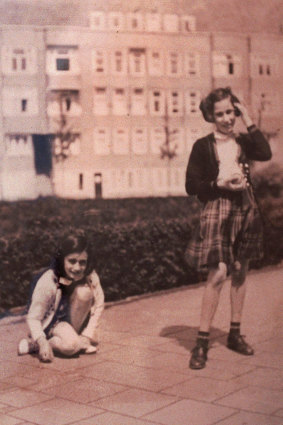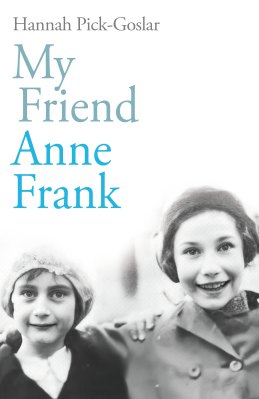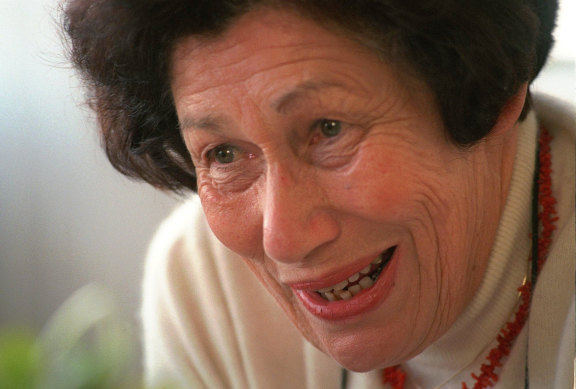By Pat Sheil
MEMOIR
My Friend Anne Frank
Hannah Pick-Goslar
Rider, $34.99
This book is well worth reading. It is deeply moving, beautifully written and, yes, you will need a tissue or two to get through it. But if you are one of the few people who have never read Anne Frank’s The Diary of a Young Girl, then you should read it, or re-read it, before opening Hannah Pick-Goslar’s remarkable memoir.
On the face of it, it seems absurd that a book by a living author called My Friend Anne Frank could have been written and published in the past two years. Anne died in Bergen-Belsen concentration camp in 1945 – almost 80 years ago.

Hannah Pick-Goslar (right) and her childhood friend Anne Frank during a game of hopscotch in Amsterdam before the war.Credit: AP
So who is this person writing in 2022, purporting to be her “friend”? When I first saw the title, I recoiled at the suspicion of a hack trying to squeeze a quid out of one of the 20th century’s most touching and tragic tales. The Diary of a Young Girl remains an astonishing collection of adolescent reflections on self and circumstance. It is made all the more poignant in that it is one of those rarest works of non-fiction when the reader knows the ending before they begin, but the writer never does.
But My Friend Anne Frank is the real deal, unlikely as the timing may seem. Pick-Goslar’s was indeed a friend of Anne’s, both Jews born in Germany (Anne in 1929, Hannah a year earlier), their families fleeing Nazism separately to the “safety” of Holland in 1933. They went to school in Amsterdam together, enjoyed the same birthday parties, and Hannah, dubbed as Hanneli, or Lies, appears several times in Anne’s diary. (Anne had a deep respect for privacy, even in this most secret file, and hid the identities of both close friends and irritating pests in a slew of pseudonyms.)

Credit:
It is this overpowering, bittersweet foreknowledge of what is to come that any reader of Anne’s diary finds so overwhelming, inspiring and yet so awful. How many of us have wept at her dreams of a romantic and intellectually adventurous future, all beginning with the words “… after the war”?
Pick-Goslar’s autobiography was written well after the war. Born in Berlin in 1928, she died aged 93 in Jerusalem last October. This story, very much her own, was co-written and edited with deft compassion and diligence by journalist Dian Kraft. It is as moving as Anne’s because not only did they play together as children, but Hannah knows how it ends.
The dreadful, transitory reunion of the two girls at Bergen-Belsen, days before Anne’s death, with Hannah throwing a sock stuffed with bread across a barbed wire fence for what was possibly Anne’s last meal, is truly heartbreaking.
For two years, Hannah and her family had been told that Anne’s family had long since escaped to Switzerland, while of course they had been hiding in the secret annex. In this surreal confinement, her writing and imagination become entangled with an inevitable self-examination of her emergence as an evolving young woman, and helpless love for the boy Peter.

Hannah Pick-Goslar in 1998, when she was 69 years old.Credit: AP
In June 1943, Hannah and her baby sister were sent to Westerbork transit camp, from where Anne and her sister, Margot, were to board the final death train, their hiding place having been betrayed to the SS in August 1944. Hannah and her sister, Gabi, were also taken to Belsen, where the privations and gratuitous cruelty only made them wonder why, how, this was happening to them, “just because we are Jews”.
Through it all, on the brink of starvation and picking lice off the head of her three-year-old sister, Hannah would close her eyes and dream of being with Anne, well fed and sound asleep in a cosy bed in Switzerland – until the day she hears her friend’s voice through a barbed wire fence stuffed with straw so that the prisoners could not see each other. Anne can barely speak; she is starving, dying of typhus. Hannah scrimps food from her barrack across the wire and throws it over. Anne screams – another woman has stolen it.
Hannah tries again the next night. The last words she hears from her friend are “got it”. The next day, the fence, tents and sheds beyond the wire are all gone, as is Anne. The Russians liberate the camps days later. Hannah, at death’s door herself, and weighing under 30 kilograms, spent months recovering in a Canadian-run hospital.
For almost 80 years, she worked as a nurse and a pre-school teacher before touring the world as a Holocaust survivor, “Anne Frank’s friend”, lecturing and telling her story. Decades after the war, she died peacefully, surrounded by generations of loving descendants, whom she’d often described collectively as her “revenge on Hitler”.
The Booklist is a weekly newsletter for book lovers from books editor Jason Steger. Get it delivered every Friday.